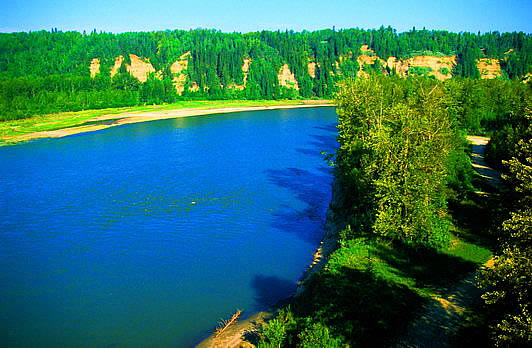In order to add items, you'll need to create an account on the site. To do this, click on Log In.
The Explorers
The first man credited with exploring the general area of Drayton Valley, aside from the First  Nations people, was David Thompson while he was working for the Northwest Company. His mission was to cross the Rocky Mountains and trade furs in the Columbia region. Competition was fierce among the fur trading companies and time was always of the essence, so Thompson and four canoes set out to oppose another company.
Nations people, was David Thompson while he was working for the Northwest Company. His mission was to cross the Rocky Mountains and trade furs in the Columbia region. Competition was fierce among the fur trading companies and time was always of the essence, so Thompson and four canoes set out to oppose another company.
On September 11th, 1810, after having sent his canoes ahead, he set out from White Earth House, a trading post close to the Alberta/Saskatchewan border, with William Henry and two First Nations guides. However, from then until the end of October of 1810, a shroud of mystery hangs over what took place. Thompson’s diary, usually very thorough, had very little information during this time.
Alexander Henry, a fellow explorer and nephew of William Henry, offered the most likely explanation in his diary. He was wintering at Rocky Mountain House and he wrote about warnings of hostile Peigans, a tribe in the area. Thompson’s canoes returned to Rocky Mountain House. On October 11th, Alexander Henry immobilized the Indians with liquor laced with laudanum so the canoes could continue. The next morning, William Henry arrived with the two First Nations people and announced that he had left Thompson on a tributary called the Brazeau.
Thompson had sent Henry and the two First Nations people ahead to Boggy Hall, an abandoned trading post. Henry discovered that Thompson’s canoe brigade had been attacked there and its members’ blood was still fresh on the rocks. After firing a signal shot, William Henry rejoined Thompson and told him what had happened. Thinking that Peigans would investigate the gunshot, He wrote, “they would be on us very early in the morning, and we must get an early start.” He also wrote that the next day, they all rode off together.
Alexander Henry’s account, however, differs considerably. He wrote that when Thompson heard of the attack, he jumped on his horse and rode off, leaving his men and his canoes. On October 12th, Alexander Henry set out to find Thompson. He located him “on the top of a hill, 300 feet above the water, where tall pines stood so thickly that [he] could not see his tent until [they] came within ten yards of it”.
of the attack, he jumped on his horse and rode off, leaving his men and his canoes. On October 12th, Alexander Henry set out to find Thompson. He located him “on the top of a hill, 300 feet above the water, where tall pines stood so thickly that [he] could not see his tent until [they] came within ten yards of it”.
Thompson, it seems, had been occupying this spot for over three weeks and was suffering the effects of starvation, presumably because he did not dare fire a shot for fear of the Peigans’ wrath.
No mention of Alexander Henry is made in Thompson’s narrative of the incident. Many experts believe that Thompson destroyed this section because of the obvious disgrace involved. Many rumors did circulate during his lifetime, casting doubts about his bravery and heroism.
This was history’s initial brush with Drayton Valley. But more was to come.





